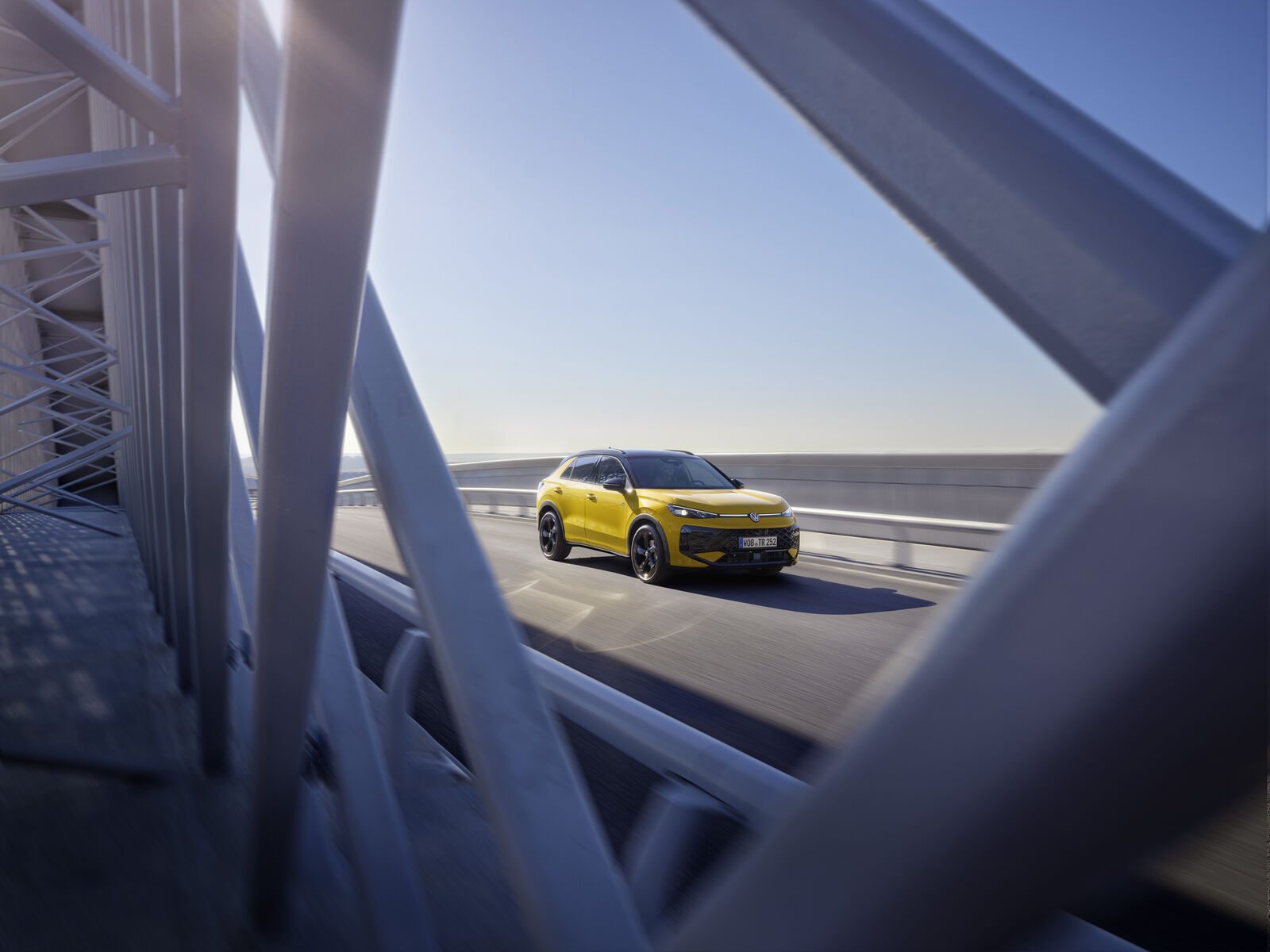Electrified across the board in Europe: Hybrid is the new default for the T-Roc
Good to know
- 48V mild hybrid as standard – the T-Roc is equipped as standard with an efficient mild hybrid turbo petrol engine (eTSI) with 85 kW (116 PS) and 7-speed dual clutch gearbox
- T-Roc R-Line with 110 kW as standard – Sporty top-of-the-range equipment specification starts with 110 kW version of the 48V mild hybrid drive (eTSI) plus 7-speed DSG
- Progressive eTSI – 1.5 TSI evo2 with Active Cylinder Management, variable-geometry turbocharger, Miller cycle and 48V belt-driven starter alternator is economical and powerful
- Hybrid, front-wheel and all-wheel drive – The new T-Roc launches in Europe with mild hybrid and front-wheel drive; further hybrid versions and all-wheel drive will follow
Six electrified drives
Basic version with 48V mild hybrid. In Europe, Volkswagen will offer the new T-Roc with innovative hybrid turbocharged petrol engines and automatic gearboxes across the board. For the launch, there are two 48V mild hybrid drives (eTSI) with 85 kW (116 PS) and 110 kW (150). These two electrified high-volume engines are coupled to a 7-speed direct shift gearbox (DSG). Two hybrid drive systems that have been developed from scratch will then follow. Both mild hybrid and hybrid versions have front-wheel drive. As with the previous model, the new T-Roc will again be available with 4MOTION all-wheel drive at a later date – combined with the 2.0-litre TSI, which will also be offered as a mild hybrid (mHEV) in the future. The two drive variants for market entry of the second-generation T-Roc in detail:
Mild hybrid
| Engine system | Power in kW / PS | Gearbox | Drive type |
| Mild hybrid | | | |
| 1.5 eTSI | 85/116 | Seven-speed DSG | Front |
| 1.5 eTSI | 110/150 | Seven-speed DSG | Front |
Turbocharged petrol engine plus 48V system. The T-Roc’s two eTSIs produce 85 kW (116 PS) and 110 kW (150 PS). Both 1.5-litre four-cylinder engines are designed as mild hybrid drives with a 48V belt-driven starter alternator. The 220 and 250 Nm (maximum torque) turbocharged petrol engines are connected to a 48V lithium-ion battery and a 48V belt-driven starter-alternator. The 48V system provides an additional 14 kW of power and 56 Nm of torque on a temporary basis. The system is supplied with electrical energy via recuperation. On the one hand, the additional boost of electrical power enables the T-Roc to perform impressively when pulling away from a standstill. At the same time, the technology makes it possible for the 1.5 TSI evo2 to be switched off completely, thereby enabling the SUV to coast.
The eTSI in detail. The 1.5 TSI evo2 from the Volkswagen EA211 engine family is a high-tech drive system with VTG turbocharger (variable turbine geometry), TSI evo combustion cycle and ACTplus Active Cylinder Management. The combination of these three parameters is a technical unique selling point in the field of large-scale production petrol engines. Another new element is the coupling of this technology to a 48V belt-driven starter alternator.
Miller cycle plus VTG turbocharger. In the TSI-evo combustion cycle, the decisive factor in terms of efficiency and power development is the symbiosis of the Miller cycle (early closing of the intake valves with high compression) and VTG charging. The petrol-air mixture is run with lambda 1 efficiency throughout the entire operating range of the engine; the TSI thus does not run either too rich (excess petrol) or too lean (excess oxygen), as the fuel is burnt completely and cleanly. Thanks to this combustion process, the 1.5 TSI evo2 operates with a very high efficiency. This minimises consumption and emissions. Other technical parameters include high-pressure injection with up to 350 bar pressure, plasma-coated cylinder liners (lower internal friction) and pistons with cast-in cooling channels (for optimisation of combustion).
ACTplus Active Cylinder Management. Besides technical features such as the TSI evo combustion process and VTG turbocharger, the T-Roc’s 1.5 TSI evo2 as eTSI is additionally equipped with ACTplus Active Cylinder Management. With ACTplus, two of the engine’s four cylinders are switched off as often as possible, depending on the operating situation. The second and third cylinders are designed to be taken out of the fuel supply at low and medium loads and speeds. Efficiency thus increases in the active cylinders, while the passive cylinders run almost loss-free. When the throttle is opened, they immediately become active again. Switches between the two- and four-cylinder drive system are virtually imperceptible to the driver.
48V system with belt-driven starter alternator. The 48 V system was designed to save fuel. Depending on the driving style and ambient conditions, savings of around half a litre per 100 km can be achieved due to coasting and load-point shifting in the engine. The 48V technology permits transmission of higher electric power levels with smaller conductor cross-sections and a compact 48V lithium-ion battery – thus also resulting in low additional weight. Compared with vehicles with pure 12 V technology, this leads to recuperation of a significantly larger amount of energy during braking or deceleration. The energy stored in the 48 V lithium-ion battery is used to supply the 48 V belt-driven starter alternator and the 12 V vehicle electrical system via a DC/DC converter. The water-cooled belt-driven starter alternator has the role of alternator and starter. At the same time, it acts as a compact electric motor, which increases the drive torque without any delay when moving off. The output of the alternator is transferred by the belt drive. The alternator also restarts the TSI – which is switched off as much as possible while the vehicle is moving. Power is transmitted to the driven front axle via a 7-speed DSG.
